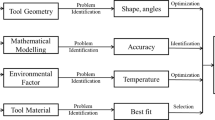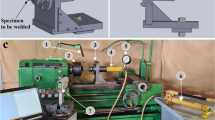Abstract
In order to avoid the deviation caused by calculating the residual stresses of welding joints with the release coefficients of the same parent metal, a new method has been proposed based on the properties of weld joints. Since the mechanical property of 2195-F Al alloy is close to that of 2219-T87 Al alloy Friction stir welding (FSW) joint, 2195-F Al alloy is selected as the substitute material of 2219-T87 Al alloy FSW joint in the calibration test. Release coefficients of 2195-F Al alloy and proper correction coefficient are used to calculate the residual stresses of 2219-T87 Al alloy FSW joints. Compared to the results calculated with release coefficients of its parent metal, it has been proved that the proposed correction method is more precise in residual stresses measurement of weld joints. The mathematical analysis and the results of verification tests have shown that this new method is reliable, and it will provide guidance in academic research and engineering application of the spherical indentation strain-gauge method.
Similar content being viewed by others
References
B. Malard, F. De Geuser and A. Deschamps, Microstructure distribution in an AA2050 T34 friciton stir weld and its evolutionduring post-welding heat treatment, Acta Materialia, 101 (2015) 90–100.
Y. Liang, S. S. Hu, J. Q. Shen, H. Zhang and P. Wang, Geometrical and microstructural characteristics of the TIG-CMT hybrid welding in 6061 aluminum alloy cladding, Journal of Materials Processing Technology, 239 (2017) 18–30.
Y. S. Sun, L. Xuan and Q. Du, Finite element analysis of welding pressing force for aluminum alloy middle roof plate of urban rail transit train, Journal of Mechanical Science and Technology, 31 (3) (2017) 1357–1363.
J. Q. Yu, G. Q. Zhao, C. S. Zhang and L. Chen, Dynamic evolution of grain structure and micro-texture along a welding path of aluminum alloy profiles extruded by porthole dies, Materials Science and Engineering A, 682 (2017) 679–690.
M. Muzamil, M. Akhtar, M. Samiuddin and M. Mehdi, Effect of heat treatment on impact resistance of AU5GT and AS7G06 aluminum alloys, Journal of Mechanical Science and Technology, 30 (10) (2016) 4543–4548.
J. H. Hattel, M. R. Sonne and C. C. Turum, Modelling residual stresses in friction stir welding of Al Alloys-a review of possibilities and future trends, International Journal of Advanced Manufacturing Technology, 76 (2015) 1793–1805.
G. M. Owolabi, D. T. Bolling, A. A. Tiamiyu, R. Abu, A. G. Odeshi and H. A. Whitworth, Shear strain localization in AA 2219-T8 aluminum alloy at high strain rates, Materials Science and Engineering A, 655 (2016) 212–220.
I. H. Onn, N. Ahmad and M. N. Tamin, Fatigue characteristics of dual-phase steel sheets, Journal of Mechanical Science and Technology, 29 (1) (2015) 51–57.
L. Buglioni, L. N. Tufaro and H. G. Svoboda, Thermal cycles and residual stresses in FSW of aluminum alloys: Experimental measurements and numerical models, Procedia Materials Science, 9 (2015) 87–96.
J. Altenkirch, A. Steuwer, M. Peel, D. G. Richards and P. J. Withers, The effect of tensioning and sectioning on residual stresses in aluminum AA7749 friction stir weld, Materials Science and Engeering A, 488 (2008) 16–24.
O. L. Djapic, P. J. Webster, P. A. Browne, G. B. M. Vaughan and P. J. Withers, Residual stress field in a friction stir welded aluminum extrusion, Materials Science Forum, 347–349 (2000) 678–683.
D.-H. Ko, D.-C. Ko, H.-J. Lim, J.-M. Lee and B.-M. Kim, Prediction and measurement of relieved residual stress by the cryogenic heat treatment for Al6061 alloy: Mechanical properties and microstructure, Journal of Mechanical Science and Technology, 27 (7) (2013) 1949–1955.
V. M. Linton and M. I. Ripley, Influence of time on residual stress in friction stir welds in agehardenable 7xxx aluminium alloys, Acta Materialia, 56 (2008) 4319–4327.
M. N. James, D. J. Hughes, D. G. Hattingh, G. R. Bradley, G. Mills and P. J. Webster, Synchrotron diffraction measurement of residual stress in friction stir welded 5383-H321 aluminum butt joints and their modification by fatigue cycling, Fatigue and Fracture of Engineering Materials and Structures, 27 (3) (2004) 187–202.
R. M. F. Paulo, P. Carlone, R. A. F. Valente, F. Teixeira-Dias and G. S. Plalazzo, Influence of friction stir welding residual stresses on the compressive strength of aluminum alloy plates, Thin-Walled Structures, 74 (2014) 184–190.
G. Pouget and A. P. Reynolds, Residual stress and microstructure effects on fatigue crack growth in AA2050 friction stir welds, International Journal of Fatigue, 30 (2008) 463–472.
M. Barsanti, M. Beghini, L. Bertini, B. D. Monelli and C. Santus, First-order correction to counter the effect of eccentricity on the hole-drilling integral method with strain-gage rosettes, Journal of Strain Analysis for Engineering Design, 51 (6) (2016) 431–443.
Q. H. Lin, H. N. Chen, J. Chen and Y. Liang, Residual stresses measurement using an indentation made by an impact load, Materials Science Forum, 490–491 (2005) 196–201.
N. Ozawa, T. Yoshizawa, T. Shoji and Y. Watanabe, Establishing the evaluation technique of the biaxial residual stress determined with the surface strain measurement under the spherical indentation, Nihon Kikai Gakkai Ronbunshu, A Hen/Transactions of the Japan Society of Mechanical Engineers, Part A, 79 (801) (2013) 546–554.
C. Q. Huang, H. Li, J. X. Li, C. G. Luo and Y. B. Ni, Residual stress measurement on propellant tank of 2219 aluminum alloy and study on its weak pot, Journal of Mechanical Science and Technology, 31 (5) (2017) 2213–2220.
Q. Yan, H. N. Chen, J. Chen and X. H. Xue, Study on joint residual stress induced by laser beam welding of high strength automobile thin sheet, Advanced Materials Research, 97–101 (2010) 3916–3919.
H. Moein and I. Sattari-Far, Different finite element techniques to predict welding residual stresses in aluminum alloy plates, Journal of Mechanical Science and Technology, 28 (2) (2014) 679–689.
P. C. Qu, H. N. Chen, Q. H. Lin and X. L. Meng, Effect of yield strength on strain increments in measuring welding stresses by an indentation strain method, Journal of Mechanical Strength, 29 (6) (2007) 904–907.
J. Chen, H. N. Chen and J. Chen, Evaluation of mechanical properties of structural materials by a spherical indentation based on the representative strain-an improved algorithm at great depth ratio, Acta Metallurgica Sinica, 24 (5) (2011) 405–414.
B. Parida, S. D. Vishwakarma and S. Pal, Design and development of fixture and force measuring system for friction stir welding process using strain gauges, Journal of Mechanical Science and Technology, 29 (2) (2015) 739–749.
Q. Z. Wang, Z. X. Zhao, Y. Zhao, K. Yan and H. Zhang, The adjustment strategy of welding parameters for spray formed 7055 aluminum alloy underwater friction stir welding joint, Materials and Design, 88 (2015) 1366–1376.
H.-H. Cho, S.-T. Hong and J.-H. Toh, Three-dimensional numerical and experimental investigation on friction stir welding processes of ferritic stainless steel, Acta Materialia, 61 (2013) 2649–2661.
K. L. Johnson, Contact mechanics, Reprint, Cambridge University Press, England, United Kingdom (1987).
X. L. Meng, H. N. Chen, Q. H. Lin and J. Chen, Stressstrain around an indentation in measuring residual stress by indentation-strain method, Transaction of the China Welding Institution, 29 (3) (2008) 109–112.
GB/T24179-2009, Metallic materials-Residual stress determination-The indentation strain-gage method (2009).
J. Chen, C. L. Huang and H. N. Chen, Relationship between the two principle strains in the three-point bending calibration test, Ordnance Material Science and Engineering, 31 (6) (2008) 37–40.
GB/T 228.1-2010, Metallic materials-Tensile testing-Part 1: Method of test at room temperature (2010).
GB/T 7314-2005, Metallic materials-Compression testing at ambient temperature (2005).
Author information
Authors and Affiliations
Corresponding author
Additional information
Recommended by Associate Editor Jin Weon Kim
Yang Du is a Ph.D. student in the Department of Materials Science and Engineering at Tianjin University, Tianjin, China, and she will get her Master and Ph.D degrees in 2019. She has received her B.S. degree from Lanzhou Technology University, Lanzhou, China in 2013. Her research areas include the mechanical properties and numerical simulation of aluminum alloy welding process.
Huan Li is currently a Professor in the Department of Materials Science and Engineering at Tianjin University, Tianjin, China. He has received his Ph.D. degree from Tianjin University in 1997. His main research areas are the arc physics, high efficiency welding and aluminum alloy welding.
Lijun Yang is currently a Professor in the Department of Materials Science and Engineering at Tianjin University, Tianjin, China. He has received his Ph.D. degree from Tianjin University in 2001. His research interests include the control technology and equipment of welding process, arc and laser plasma physics.
Rights and permissions
About this article
Cite this article
Du, Y., Li, H., Yang, L. et al. Accurate measurement of residual stresses of 2219-T87 aluminum alloy friction stir welding joints based on properties of joints. J Mech Sci Technol 32, 139–147 (2018). https://doi.org/10.1007/s12206-017-1215-9
Received:
Revised:
Accepted:
Published:
Issue Date:
DOI: https://doi.org/10.1007/s12206-017-1215-9




